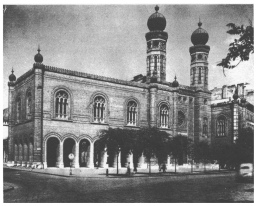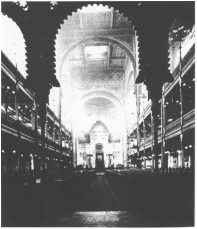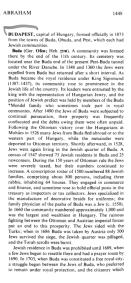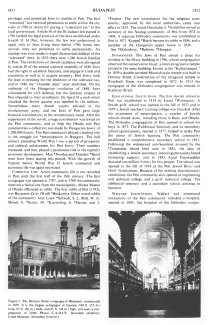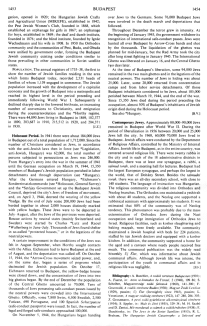<BUDAPEST,
capital of Hungary, formed officially in 1873 from the towns
of Buda, Obuda, and Pest, which each had Jewish communities.
Buda (Ger. Ofen).
[Expulsions of 1348 and 1360 - Buda as a royal residence
under King Sigismund]
A community was formed there by the end of the 11th century.
Its cemetery was located near the Buda end of the present
Pest-Buda tunnel under the River Danube. In 1348 and 1360
the Jews were expelled from Buda but returned after a short
interval. As Buda became the royal residence under King
Sigismund (1387-1437), its community rose to prominence in
the Jewish life of the country. Its leaders were entrusted
by the king with the representation of Hungarian Jewry, and
the position of Jewish prefect was held by members of the
Buda *Mendel family who sometimes took part in royal
ceremonies.
[Persecutions since 1490 -
flight to western Hungary in 1526 - deportation to Ottoman
territory - Jews in Buda since 1528 - professions]
After 1490 the Jews of Buda were subjected to continual
persecution, their property was frequently confiscated and
the debts owing them were often unpaid. Following the
Ottoman victory over the Hungarians at Mohács in 1526 many
Jews from Buda fled abroad or to the western part of
Hungary, while the remainder were deported to Ottoman
territory.
Shortly afterward, in 1528, Jews were again living in the
Jewish quarter of Buda. A census of 1547 showed 75 Jewish
residents in Buda and 25 newcomers. During the 150 years of
Ottoman rule the Jews were severely taxed, but their numbers
continued to increase. A conscription roster of 1580
numbered 88 Jewish families, comprising about 800 persons,
including three rabbis, inhabiting 64 houses. They engaged
in commerce and finance, and sometime rose to hold official
posts in the treasury as inspectors or tax collectors. Jews
specialized in the manufacture of decorative braids for
uniforms; the family physician of the pasha of Buda was a
Jew (c. 1550). In 1660 the community numbered approximately
1,000 and was the largest and wealthiest in Hungary.
[Austrian destruction of
the Jewish community - resettlement since 1689 - many
expulsions - Jews prohibited from 1746-1783 under Maria
Theresa]
The ruinous fighting between the Ottoman and Austrian
imperial forces put an end to this prosperity. The Jews
sided with the Turks; when in 1686 Buda was taken by Austria
only 500 Jews survived the siege, the Jewish quarter was
pillaged, and the Torah scrolls were burnt.
Jewish residence in Buda was prohibited until 1689, when a
few Jews began to resettle there and had a prayer room by
1690. In 1703, when Buda was constituted a free royal city,
a struggle began between the Jews of Buda, who preferred to
remain under royal protection, and the citizenry which (col.
1448)
made efforts to extend its jurisdiction to the Jewry. This
culminated in a decree ordering the expulsion of the Jews in
1712. In 1715 Charles III ordered the burghers to end the
continual disturbances and a more tranquil period ensued. A
few Jewish families were exempted by the emperor from
certain restrictions. The exemptions led to an attack and
plunder of Jewish homes in the fall of 1720. Charles
however, again gave them protection. According to a 1735
census, the community numbered 35 families (156 persons),
the majority merchants; five families owned open stalls.
The repeated accusations of the citizenry bore fruit,
however, under *Maria Theresa who in June 1746 issued a
decree ordering the expulsion of the Jews from Buda. The
obstinate resistance of the burghers was broken by *Joseph
II, and in 1783 Jewish residence was again permitted. The
antagonism of the guilds recrudesced during the Hungarian
revolution of 1848 when renewed demands were made for the
Jews' expulsion.
[[The criminal racist Church was the driving force of
anti-Semitism but is never mentioned in this article.
Napoleon times are not mentioned. World War I with it's
migration movements and the collapse of the stock exchange
of 1929 is not mentioned in this article]].
COMMUNAL LIFE.
Organized communal life in Buda dates to the 13th century.
Under King *Matthias Corvinus (1458-90) the head of this
community had jurisdiction over the Jews of the entire
country. During the Ottoman era, Buda Jewry had Sephardi and
Ashkenazi congregations. Two synagogues are known to have
existed in 1647.
RABBIS.
The first rabbi whose name is recorded was *Akiva b. Menahem
ha-Kohen (15th century) known by the honorific of
nasi [[patriarch]]. In
the second half of the 17th century difficulties in finding
appropriate candidates for the rabbinate of Buda compelled
the community to employ as rabbis scholars passing through
Hungary on pilgrimage to Erez Israel (Ereẓ Israel) [[Land of
Israel]]. *Ephraim b. Jacob ha-Kohen, a refugee from Vilna,
became rabbi of Buda in 1660. About this time the movement
of *Shabbetai Zevi (Ẓevi) gained a large following in Buda;
a number of rabbis, among them Ephraim's son-in-law Jacob
Sak, supported the messianic movement. The Austrian capture
of Buda is recorded in the
Megillat Ofen [[document roll of Ofen]] of
Isaac B. Zalman *Schulhof. Jacob's son was the celebrated
Zevi (Ẓevi) Hirsch *Ashkenazi (Hakham Zevi (Ḥakham Ẓevi)).
Among rabbis of the Haskalah period [[enlightenment]] was
Moses Kunitzer. Prominent Jews of Buda in the 19th and 20th
centuries include the orator and poet Arnold Kiss (d. 1940),
and the scholar and educator Rabbi Bertalan Edelstein (d.
1934). (col. 1449)
SYNAGOGUES.
The synagogue of the Jewish community of Buda fort is
mentioned in the Buda chronicle of 1307 as having stood
beside the Jews' Gate. It remained in existence until the
expulsion of the Jews from Buda in 1360. The second
synagogue, built in 1461 in the new Jews' Street, survived
until the recapture of Buda. It is mentioned and reproduced
in 17th-century engravings. A Sephardi house of worship has
been revealed, dating back to the Ottoman era. Subsequently
the Jews of Buda could only hold prayer meetings in rented
rooms. In 1866 a temple was built in Moorish style in
Öntöház Street. In the heyday of assimilationism (from the
mid-19th century), especially after the administrative union
of Buda and Pest, the Pest community repeatedly tried to
impose its hegemony on that of Buda, which, however,
succeeded in safeguarding its unique historical character.
The Buda community opened an elementary school in 1830.
Obuda (Hung. Óbuda, Ger.
Alt-Ofen).
"Old Buda", village and later part of Buda. Obuda had a
Jewish community in the 15th century which disappeared after
the Ottoman conquest in 1526. It was rehabilitated from 1712
on, when the Jews lived under the protection of the counts
Zichy, who granted them a charter in 1746, and to whom they
paid an annual protection tax.
The 1727 census records 24 Jewish families living in Obuda,
and the 1737 annual conscription roster, 43. By 1752 there
were 59 families, and the community employed two rabbis and
three teachers; by 1784 there were 109 families with four
teachers.
The 1803 conscription list records 527 families. An
elementary school was opened in 1784, the first secular
Jewish school in the country. Moses *Muenz was rabbi in
Obuda from 1781 to 1831. the Jewish linen weavers of Obuda
won a reputation for the town; the Goldberger factory had an
international reputation.
After the revolution of 1848-49 a large contribution was
levied on the Obuda community. The old synagogue of Obuda
was demolished in 1817 and an imposing new one, still in
existence, was consecrated in 1820. Julius *Wellesz was
rabbi of Obuda from 1910 to 1915.
[[The criminal racist Church was the driving force of
anti-Semitism but is never mentioned in this article.
Napoleon times are not mentioned. World War I with it's
migration movements and the collapse of the stock exchange
of 1929 is not mentioned in this article]].
Pest.
[Jews under Ottoman rule -
anti-Semitic Austrian rule - Jews prohibited 1686-1786 -
"toleration tax" 1786-1846]
Jews are first mentioned in Pest in 1406; in 1504 they owned
houses and land. Records again mention Jews living in Pest
from the middle of the 16th century [[under Ottoman rule]],
and a cemetery is known to have existed by the end of the
17th.
After the Austrian conquest in 1686, Jewish residence within
the city was prohibited. In the middle of the 18th century
Jews were allowed to attend the country-wide weekly markets
held in Pest, but the only Jews permitted to stay in the
city for a specified time were Magranten ("transients"; see
*Familiants laws). In 1783 Joseph II abrogated the municipal
charter with its exclusion (col. 1450)
privileges and permitted Jews to resettle in Pest. The first
"tolerated" Jew received permission to settle within the
city walls in 1786 in return for paying a "toleration tax"
to the local governorate. Article 38 of the
De Judaeis law passed
in 1790 ratified the legal position of the Jews established
under Joseph II.
In Pest, however, the law was understood to apply only to
Jews living there before 1790, hence new arrivals were not
permitted to settle permanently. An attempt was even made to
expel the married children of the "tolerated" Jews. In 1833
there were 1,346 Jewish families in Pest. The restrictions
on Jewish residence were abrogated by Article 29 of the
annual national assembly of 1840. Jews had the right to
establish factories, and engage in trade and commerce as
well as to acquire property. Pest Jewry took the lead in
pressing for the abolition of the tolerance tax, and in 1846
the "chamber dues" were abolished.
[Revolution of 1848 with
riots against Jews - "contribution" - emancipation and
prosperity]
On the outbreak of the Hungarian revolution of 1848, Jews
volunteered for civil defense, but the German citizens of
Pest objected to their enrollment. On April 19 a mob which
attacked the Jewish quarter was repelled by the military.
Nevertheless many Jewish youths enlisted in the
revolutionary army, and the Jews of Pest gave large
financial contributions to the revolutionary cause. After
the suppression of the revolt, a huge contribution was
levied on the Pest community, and to help the Obuda and Pest
communities a collection was made by Hungarian Jewry of
1,200,000 forints.
The Pest community played a leading role in the struggle for
*emancipation in Hungary. The half century preceding World
War I was a period of prosperity and cultural achievement
for Pest Jewry. Their numbers increased, and they played a
prominent role in the capital's economic development. Max
*Nordau and [[racist]] Theodor *Herzl were born there during
this period. With the growth of Nazism before World War II
Jewish communal and economic life was again restricted.
[[The criminal racist Church was the driving force of
anti-Semitism but is never mentioned in this article.
Napoleon times are not mentioned. World War I with it's
migration movements and the collapse of the stock exchange
of 1929 is not mentioned in this article]].
COMMUNAL LIFE.
Active community life is not recorded in Pest until the
first half of the 18th century. The first synagogue was
opened in 1787, and in 1788 the community received a burial
site from the municipality; Moses Muenz of Obuda officiated
as rabbi. The first rabbi of Pest (1793), was Benjamin Ze'ev
(Wolf) *Boskowitz. Other noted rabbis of the community were
Loew *Schwab, S.L. Brill, W.A. Meisel, S. *Kohn, M.
*Kayserling, S. *Hevesi, and J. (col. 1451)
*Fischer. The new constitution for the religious community,
approved by the local authorities, came into effect in 1833.
The noted Orientalist I. *Goldziher served as secretary of
the Neolog community of Pest from 1874 to 1904. A separate
Orthodox community was established in Pest in 1871. Koppel
*Reich became its rabbi in 1886, and a member of the
Hungarian upper house in 1926.
See *Orthodoxy, *Reform, *Hungary.
SYNAGOGUES.
The Jews of Pest rented a place for worship in the Orczy
building in 1796, whose congregation observed the
conservative ritual; a more progressive temple existed in
the same building, known as the "Kultustempel". In 1859 a
double-turreted Moorish-style temple was built in Dohány
Street. Construction of the octagonal temple in Rombach
Street was completed in 1872. In 1913 the synagogue of the
Orthodox congregation was erected in Kazinczy Street.
EDUCATIONAL INSTITUTIONS.
The first Jewish school in Pest was established in 1814 by
Israel *Wahrmann. A Jewish girls' school was opened in the
fall of 1852 and in 1859 a Jewish teachers' training college
was founded. After the attainment of emancipation, a number
of Jewish schools closed down, including those in Buda and
Obuda. The Orthodox congregation of Pest opened its school
for boys in 1873. The Rabbinical Seminary and its secondary
school (gymnasium), opened in 1877, helped to make Pest the
center of Jewish learning. The Pest community established a
comprehensive secondary school in 1891.
Following the widespread anti-Semitism aroused by the
*Tiszaeszlar blood libel case in 1882, the idea of
establishing a Jewish secondary school (gymnasium) found
increasing support, and in 1892 Antal Freystaedtler donated
one million forints for this project. The school was opened
in the fall of 1919 as the Pest Jewish Boys' and Girls'
Gymnasium. Because of the existing discriminatory
restrictions, the Pest community also opened an engineering
and technical college and a girls' technical college. The
rabbinical seminary and a secondary school continue to
function.
WELFARE INSTITUTIONS.
Welfare and communal institutions of the Pest community
included a hospital, opened in 1841; the hospital of the
Orthodox congregation (col. 1452)
opened in 1920; the Hungarian Jewish Crafts and Agricultural
Union (MIKEFE), established in 1842; the Pest Jewish Women's
Club, founded in 1868, which established an orphanage for
girls in 1867; an orphanage for boys, established in 1869;
the deaf and dumb institute, founded in 1876; and the blind
institute, founded by Ignác Wechselmann and his wife in
1908. (col. 1453)
[[The criminal racist Church was the driving force of
anti-Semitism but is never mentioned in this article.
Napoleon times are not mentioned. World War I with it's
migration movements and the collapse of the stock exchange
of 1929 is not mentioned in this article]].
POPULATION.
the annual registers of 1735-38, the first to show the
number of Jewish families residing in the area which forms
Budapest today, recorded 2,531 heads of families of whom
1,139 engaged in commerce. The Jewish population increased
with the development of a capitalist economy and the growth
of Budapest into a metropolis and reached its highest level
in the period preceding and immediately following World War
I. Subsequently it declined sharply due to the lowered
birthrate, an increasing number of conversions to [[racist]]
Christianity, and emigration during the counterrevolution
and the *Horthy regime. There were 44,890 Jews living in
Budapest in 1869, 102,377 in 1890, 203,687 in 1910, 215,512
in 1920, and 204,371 in 1930.
[J.Z.]
[[Emigration movement after the collapse of the stock
exchange of 1929 was going on]].
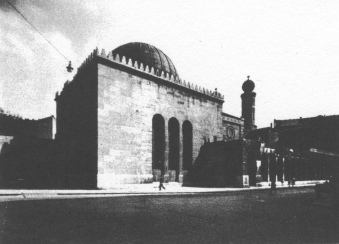
Encyclopaedia Judaica (1971): Budapest, vol. 4, col. 1450.
The Heroes' Synagogue
in Budapest, built in 1929. Photo C.A.H.J.P., Jerusalem
In 1941 there were about 184,000 Jews in Budapest out of a
total population of 1,712,000. Since the number of
Christians considered as Jews, in accordance with the
anti-Jewish laws then in force (see *Legislation,
anti-Jewish, Hungary) was 62,000, the total number of
persons subjected to persecutions as Jews was 246,000. From
Hungary's entry into the war in the summer of 1941 until the
German occupation on March 19, 1944, 15,350 members of
Budapest's Jewish population perished in labor detachments
and through deportation (see *
Hungary).
After the Germans entered Hungary, *Eichmann's
Sondereinsatzkommando (see *Holocaust, General Survey) and
the *Sztójay Government set up the Budapest Jewish Council,
deprived the city's Jews of freedom of movement, and, on
April 3, 1944, decreed the wearing of the yellow *
badge.
By the end of July some 200,000 Jews had been herded
together in about 2,000 houses distinctly marked with yellow
badges. These Jews were to be deported in July-August, after
the Jews of the provinces were deported.
Rescue actions by neutral states (mainly Switzerland and
Sweden) were started by Charles *Lutz and Raoul *Wallenberg
in June-July. Thousands of Jews found shelter in so-called
"protected houses", or in the legations of the neutral
powers.
[[Swiss government was not
"neutral"
The anti-Semitic Swiss government of Switzerland played a
cruel game with the world serving the Nazi administration up
to the end giving credits and with help for any transaction
and working force for the Wehrmacht up to the end of the
war, stamping passports with a "J" and rejecting Jews at the
frontiers etc. The pro-Jewish actions were a welcome mean
for the later history propaganda after 1945, and the Nazi
line of the Swiss government was hidden up to the 1990s...]]
A certain improvement in the conditions of the Jews was felt
in August-September, when Horthy sought contacts with the
Allies. Eichmann had to leave Budapest at the end of August,
and the deportation was called off.
[Arrow-Cross government
1944-1945 - Eichmann coming back, riots, ghettos - the
"International Ghetto" of Budapest - forged passports -
deportations and death marches]
On October 15, 1944 the *Arrow-Cross movement seized power,
and, on the same day, began a series of pogroms which
decimated the Jewish population. On October 17, Eichmann
returned to Budapest, the yellow-badge houses were closed
down, and the concentration of Jews into two big ghettos
began. By the end of December the population of the Central
Ghetto amounted to 70,000.
Tens of thousands of Jews possessing safe-conduct passes
issued by the neutral powers were crowded into the
International Ghetto. Officially, some 7,800 Swiss, 4,500
Swedish, 2,500 Vatican, 698 Portuguese, and 100 Spanish
Schutzpaesse
(safe-conduct passports) were issued. In fact the number of
legal and forged safe-conducts approached 100,000.
On November 5, 1944, the Hungarians began handing (col.
1453)
over Jews to the Germans. Some 76,000 Budapest Jews were
involved in the death march and deportations that followed.
Throughout December the terror grew in intensity. At the
beginning of January 1945, the government withdrew its
recognition of international safe-conduct passes. Jews were
hunted all over Budapest by Arrow-Cross bands and shot by
the thousands. The liquidation of the ghettos was planned
for mid-January, but the Red Army took the city after long
street fighting in January 1945. The International Ghetto
was liberated on January 16, and the Central Ghetto two days
later.
[Communist occupation of
Budapest since January 1945]
At the time of Budapest's liberation [[Communist
occupation]], some 94,000 Jews remained in the two main
ghettos and in the legations of the neutral powers. The
number of Jews in hiding was about 25,000. Later, some
20,000 returned from concentration camps and from labor
service detachments. Of those Budapest inhabitants
considered to be Jews, about 105,000 perished between March
19, 1944, and the end of the war. Since 15,350 Jews died
during the period preceding the occupation, almost 50% of
Budapest's inhabitants of Jewish origin died during the
Holocaust period.
[[There is no number about the hideouts, changing religion
or changing name. Jews who had changed religion or changed
their name with forged documents were not counted as Jews
any more and failed in the statistics. This is missing in
this article. Also the fact that many Jews were drawn into
the Red Army for fighting on the front in 1945 and died on
the front is not mentioned in the article]].
See also *Hungary.
[B.V.] (col. 1454)
Contemporary Jewry.
[Number - unification of
the Jewish communities of Buda, Obuda and Pest in 1950 -
exodus of 1956 - Jewish cultural life]
Approximately 80,000-90,000 Jews remained in Budapest after
World War II. (col. 1454) [[...]]
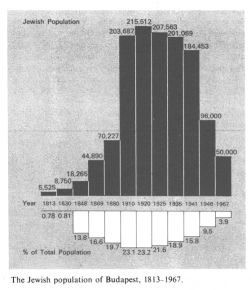
Encyclopaedia Judaica (1971): Budapest, vol. 4, col. 1449.
Graphics
of the Jewish population of Budapest, 1813-1967
In 1950 the Orthodox community and the communities of Pest,
Buda, and Obuda were unified by government order, forming
the Budapest Jewish community existing under conditions
similar to the prevailing in other communities in Soviet
satellite states. (col. 1453) [[[...]]
During the period of liberalization in 1956 between 20,000
and 25,000 Jews left the city. [[...]]
Jewish affairs were conducted by the Department of Religious
Affairs, controlled by the Ministry of Internal Affairs.
Jewish life in Budapest, as in the entire country, was
centered around religious life. There were twenty rabbis in
the city and in each of the 18 administrative districts in
Budapest, there was at least one synagogue, a rabbi, a
talmud torah, and a
meeting hall for lectures. Budapest had the largest European
synagogue, and perhaps the largest in the world, that of
Dohány Street.
Besides the
talmudei
torah, there was an all-day secondary school, with
close to 140 students. The language of instruction was
Hungarian. The religious community was divided into Orthodox
and Neolog branches. The Orthodox one maintained a yeshivah
[[religious Torah school]] with about 40 students, and the
Neolog one supported a rabbinical seminary with
approximately ten students. It was estimated that 80% of the
community was of Neolog tendency. This phenomenon was
probably due to the mass extermination of Orthodox Jews
during the Nazi occupation and large immigration of Orthodox
Jews to [[racist Zionist Free Mason CIA Herzl]] Israel.
Religious facilities, such as kosher slaughtering and baking
mazzah (maẓẓah), were freely available. The community
maintained a Jewish hospital with beds for 224 patients,
staffed by ten Jewish doctors and equipped with a kosher
kitchen. In addition, the community supported a home for the
aged and a canteen where needy people received free meals.
The communal publication was the widely read biweekly
Úy Élet [[New Life]],
which was informative about Jewish communal affairs.
Although Jewish life was intense, the participation of the
youth in communal affairs and in religious life was
negligible. [[...]]
In 1968, 60,000-70,000 Jews lived in Budapest. [[...]]
[ED]> (col. 1454)
